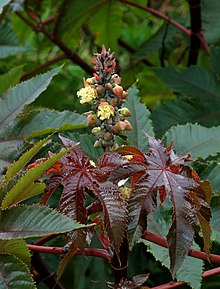| Ricinus | |
|---|---|

| |
| Leaves and inflorescence (male flowers below female flowers) | |
| Scientific classification | |
| Kingdom: | Plantae |
| Clade: | Tracheophytes |
| Clade: | Angiosperms |
| Clade: | Eudicots |
| Clade: | Rosids |
| Order: | Malpighiales |
| Family: | Euphorbiaceae |
| Subfamily: | Acalyphoideae |
| Tribe: | Acalypheae |
| Subtribe: | Ricininae |
| Genus: | Ricinus L. |
| Species: | R. communis
|
| Binomial name | |
| Ricinus communis L.
| |
Ricinus communis, the castor bean[1] or castor oil plant,[2] is a species of perennial flowering plant in the spurge family, Euphorbiaceae. It is the sole species in the monotypic genus, Ricinus, and subtribe, Ricininae. The evolution of castor and its relation to other species are currently being studied using modern genetic tools.[3] It reproduces with a mixed pollination system which favors selfing by geitonogamy but at the same time can be an out-crosser by anemophily (wind pollination) or entomophily (insect pollination).[4]
Its seed is the castor bean, which despite the term is not a bean (as it is not the seed of a member of the family Fabaceae). Castor is indigenous to the southeastern Mediterranean Basin, East Africa, and India, but is widespread throughout tropical regions (and widely grown elsewhere as an ornamental plant).[5]
Castor seed is the source of castor oil, which has a wide variety of uses. The seeds contain between 40% and 60% oil that is rich in triglycerides, mainly ricinolein. The seed also contains ricin, a highly potent water-soluble toxin, which is also present in lower concentrations throughout the plant [citation needed].
The plant known as "false castor oil plant", Fatsia japonica, is not closely related.
- ^ USDA, NRCS (n.d.). "Ricinus communis". The PLANTS Database (plants.usda.gov). Greensboro, North Carolina: National Plant Data Team. Retrieved 1 February 2016.
- ^ "Ricinus communis: Castor oil plant". Oxford University Herbaria. Dept. of Plant Sciences, Oxford.
The castor oil plant is one of the few major crops to have an origin in Africa.
- ^ "Euphorbiaceae (spurge) genomics". Institute for Genome Sciences. University of Maryland Medical School. Retrieved 9 March 2009.
- ^ Rizzardo, RA; Milfont, MO; Silva, EM; Freitas, BM (December 2012). "Apis mellifera pollination improves agronomic productivity of anemophilous castor bean (Ricinus communis)". Anais da Academia Brasileira de Ciências. 84 (4): 1137–45. doi:10.1590/s0001-37652012005000057. PMID 22990600.
- ^ Phillips, Roger; Rix, Martyn (1999). Annuals and Biennials. London: Macmillan. p. 106. ISBN 978-0-333-74889-3.